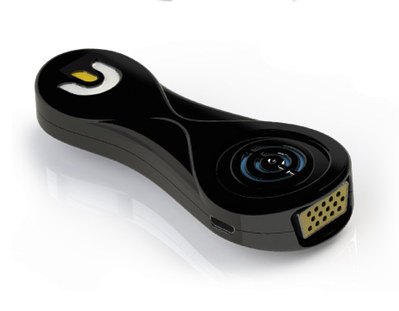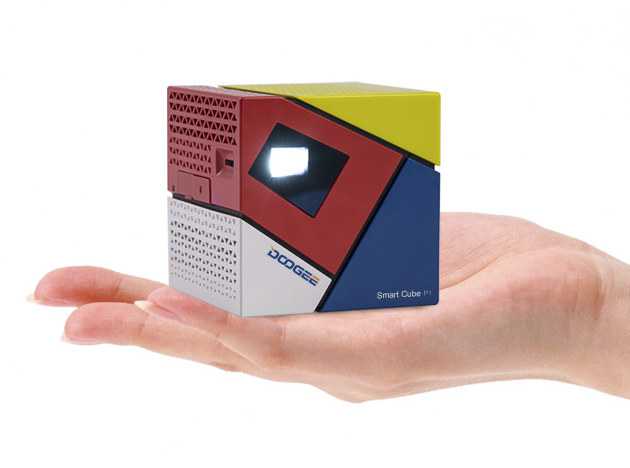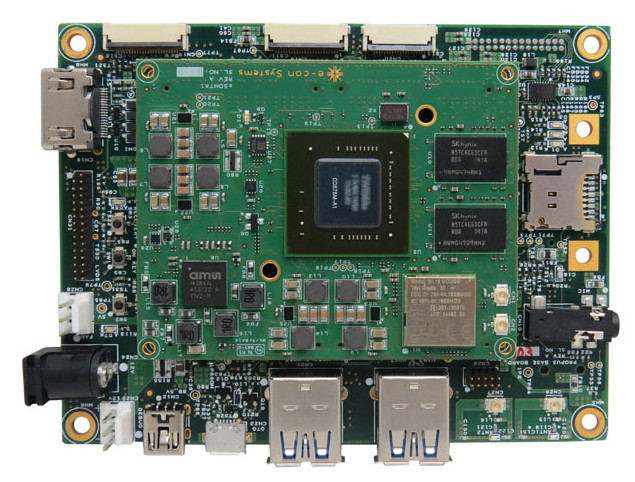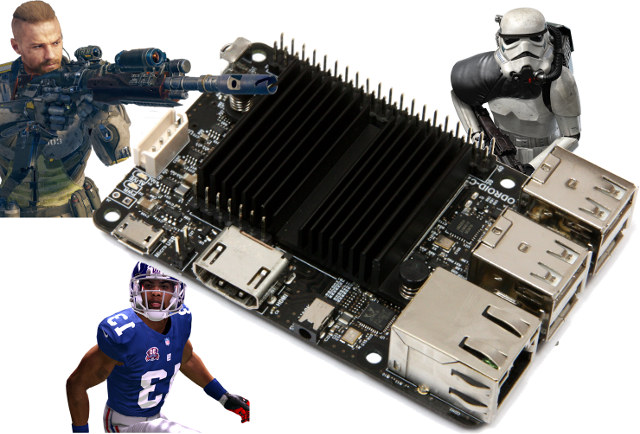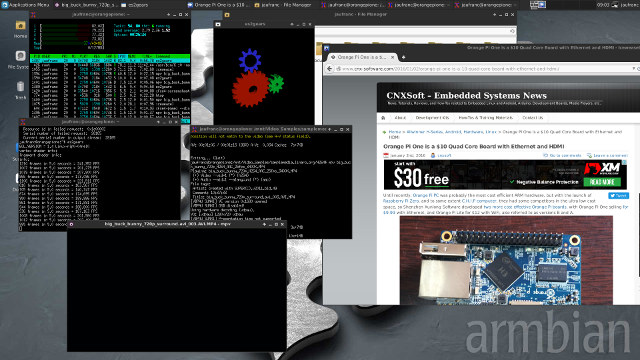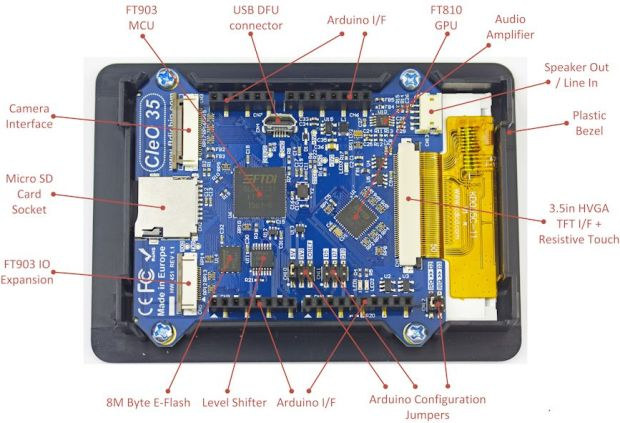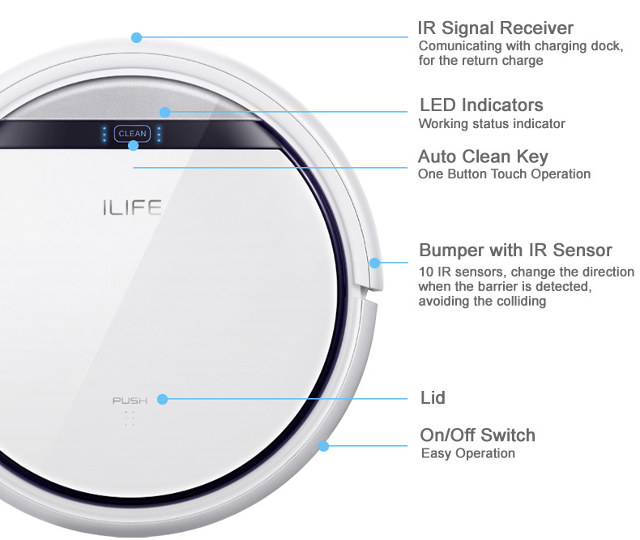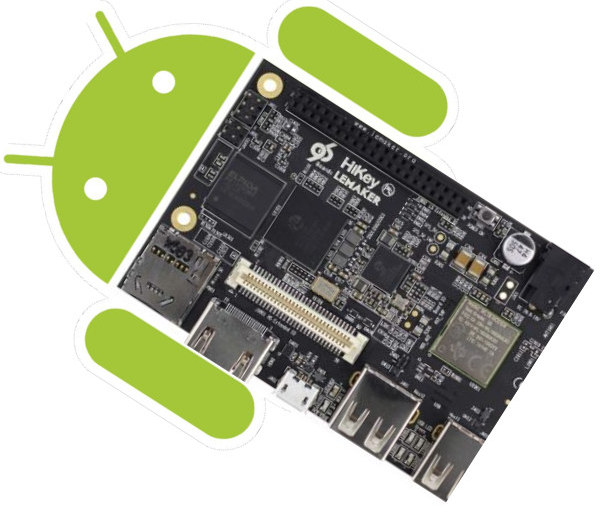You have already many options to mirror your mobile device’s screen to a big TV or projector with Chromecast, Miracast adapters, or EZCast dongles. However, if you want to connect it to a projector with a VGA connect you’ll need a separate HDMI to VGA adapter, and some devices may require Internet access, which you may or may not have during your presentations. WeKast dongle have been designed to simplify the process of setting up your presentation on any premises with HDMI and VGA output, and no requirement for WiFi connectivity. Simply copy your presentation on your smartphone, connect the dongle, and you’re ready to get started using WeKast app on your Android or iOS smartphone. WeKast hardware specifications: CPU – 1.6GHz processor System Memory – 1GB RAM Connectivity – 802.11 b/f/n with WPA2 enterprise security Video Output – Female HDMI and female VGA ports USB – 1x micro USB […]
Doogee P1 is a Tiny Android 4.4 DLP Projector That Supports Screen Mirroring and Extension over WiFi
Doogee Smart Cube P1 looks like a colorful Android 4.4 TV box powered by an Amlogic quad core processor, but it’s actually an Android DLP projector without other video output ports (no HDMI, no composite) that can also be used to mirror or extent your laptop or smartphone screen. Doogee P1 specifications: SoC – Amlogic quad core processor (likely Amlogic S805 quad core Cortex A5 since the device is running Android 4.4) System memory – 1GB DDR3 Storage – 8GB eMMC flash Projector Texas Instrument DLP with 70 lumen/3W brightness, OSRAM LED, and 30,000 hours LED lifetime Resolution – 854×480; max: 1280×720 Contrast ratio – 800:1 Manual focus Audio – 2x 1.2W speakers Connectivity – 802.11 b/g/n and Bluetooth USB – 1x USB 2.0 host port, 1x micro USB OTG port Misc – Dual LED charging LED, power and reset buttons Power Supply – 5V via USB OTG port Battery […]
e-Con Systems Propus Nvidia Tegra K1 Development Board Features 3 MIPI-CSI Camera Interfaces
I mostly know e-Con Systems because of their camera modules, but the Indian company has also been manufacturing system-on-modules and development kits, and has just launched Propus development board based on their eSOMTK1 computer-on-module powered by Nvidia Tegra K1 quad core Cortex A15 processor, and including three camera interfaces with two 4-lane and one 1-line MIPI-CSI2 connectors. Propus specifications: Computer-on-module – eSOMTK1-F16G-R2G-WB-IM: SoC – Nvidia Tegra K1 4-plus-1 ARM Cortex-A15 processor @ up to 2.3 GHz with 192-core Kepler GPU. System Memory – 2GB 64-bit DDR3L SDRAM Storage – 16GB eMMC flash Connectivity – 802.11 a/b/g/n and Bluetooth 4.1 module with 2 u.Fl antenna connectors Sensors – 3D digital accelerometer and a 3D digital gyroscope (6 axis) Power Management IC (5V and 12V inputs) SoM connectors – 4x 100-pin board to board connectors Storage – SATA connect, micro SD slot Video Output – 1x HDMI 1.4 Audio – Audio Codec […]
Play High-end PC Games on ARM Linux Boards with Moonlight Embedded
Nvidia first showcased PC games streaming to Nvidia Project SHIELD Game Console at CES 2013, and since then Moonlight project has been created to provide an open source implementation compatible with Nvidia Gamestream, and supported on Linux, Mac OS and Windows PC, Android & iOS mobile devices, as well as Samsung VR kits. There’s also an implementation called Moonlight Embedded designed for ARM Linux platforms such as Raspberry Pi,ODROID, Cubox-i boards, and ODROID-C1 and ODROID-C2 boards even got support for H.265 streaming very recently allowing for better quality over H.265 at a given bit rate, and possibly 4K @ 60 Hz gaming on ODROID-C2 board. You’ll need a Windows gaming PC with an Nvidia GTX 600/700/900 series GPU, a wired connecting or a high-end 802.11 router or greater, and Nvidia Geforce Experience (GFE) installed on your PC. H.265 requires an Nvidia 900 series GPU such as Nvidia GTX960. Once this […]
Accelerated 3D Graphics, Hardware Video Decoding, and Network Performance on Orange Pi One Board (Video)
I’ve just written Getting Started Guide for Orange Pi One, a $10 development board based on Allwinner H3 quad core Cortex A7 processor, where I explain how to install and configure Armbian distribution on the board. As promised, I’ve also tested 3D graphics acceleration, and hardware video decoding, and also included some Ethernet benchmarks. Since ARM Mali-400 GPU found in Allwinner H3 is only capable of OpenGL ES, as in most ARM SoCs, you can test 3D graphics acceleration by using es2gears (and not glxgears as I’ve seen some other do in the past):
|
1 2 3 4 5 6 |
es2gears EGL_VERSION = 1.4 Linux-r3p0-04rel0 vertex shader info: fragment shader info: info: 1463 frames in 5.0 seconds = 292.425 FPS |
The log shows the utility is using Linux-r3p0 Mali driver, and the gears are display at a high frame rate close to 300 fps. If I switch to full screen, the frame rate drops to about 43 fps, which should still be acceptable. CedarX is the infamous closed source and GPL violating media library released […]
Cleo35 Touchscreen Display for Arduino UNO Comes with Tutorials and Example Projects (Crowdfunding)
There are already various options to add a (touscheen) display to Arduino board with software support including TFTLibrary for Arduino, and recently I tried Nextion serial touchscreen displays that are supported by a WYSIWYG editor, but the latter is only supported in Windows and not exactly user-friendly, and I found the few provided tutorials would only work with a specific resolution incompatible with the displays I had been sent. So I gave up on the idea of interfacing the display with Arduino or ESP8266 as it would be too time-consuming. FTDI CleO project might be faster and easier to get started, as their CleO35 touchscreen display for Arduino UNO will come with a 20 chapter tutorial covering over 80 topics, and 20 projects to get started. Some of the key features and specs of Cleo35 display include: MCU – FTDI FT903 32-bit FT32 core @ 100MHz with 256kB on-chip Flash […]
$100 Chuwi Ilife V5S Autonomous Robotic Vacuum Cleaner Offers an Alternative to iRobot Roomba
iRobot Roomba autonomous vacuum cleaners have been around since 2002, with the robots automatically cleaning the floor, detecting walls and edges, going around table and chair feet, etc… The company also produced iCreate 2 programmable robot for educators, students and developers who wants to learn about robotics, and works with Arduino and Raspberry Pi boards. I had seen similar cleaners from Chinese vendors in the past, with prices starting at $30, but they looked basically useless based on the specs, but yesterday I discovered Chuwi Ilife V5S robotic vacuum cleaner and mop that seems pretty decent, and even can go back to its charging station automatically. Chuwi Ilife V5S key features and specifications: Anti-collision System, drop avoidance induction 50db low noise design; 850pa strong suction Sensors – 10 IR sensor on sides and bottom, OBS (Optical backscatter point sensor) sensors, 1 set wall sensor. (Note: OBS is based on IR, […]
96Boards Hikey Development Board is Now Officially Supported in AOSP
Hikey is a one of the first 96Boards compliant development board manufactured by either LeMaker in China and CircuitCo in the US, and while the hardware requirements of 96Boards specifications are rather easy to meet, the software requirements including “bootloader (open source), accelerated graphics support (binary or open source), a Linux kernel buildable from source code based from mainline, or the latest Google-supported Android kernel version” are much harder to comply with. Linaro had a very good news for Linaro Connect Bangkok as they announced Hikey board was supported in Android Open Source Project (AOSP). So that means Hikey board will run the latest version of Android like Google Nexus devices, with the advantage of also getting more recent devices. If you want to build an Android image from AOSP just retrieve the source code:
|
1 2 |
repo init -u https://android.googlesource.com/platform/manifest repo sync -j8 |
Grab & extract vendors binaries for Hikey from Google.com. and complete the build:
|
1 2 3 |
source build/envsetup.sh lunch hikey-userdebug make -j8 droidcore |
[…]


